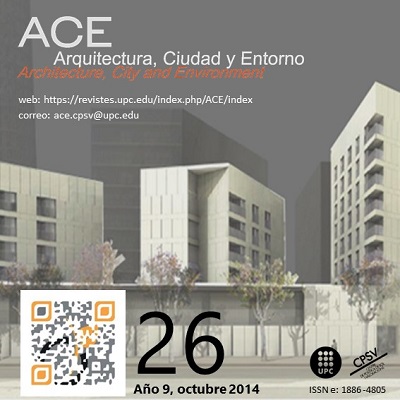State policies in areas of integral rehabilitation, urban typology and social vulnerability
DOI:
https://doi.org/10.5821/ace.9.26.3686Keywords:
Comprehensive rehabilitation areas, housing plans, urban rehabilitation, urban regeneration.Abstract
During the real estate boom, obtaining surplus through the development of new construction operations was carried through the end. Already in the years before the bursting of the housing bubble, and even more thereafter, rehabilitation and urban regeneration policies have been presented as a solution for a sector in crisis. But this cannot be the only objective, it is necessary to consider rehabilitation in urban areas as a tool for rebalancing the fragmented city and the incorporation of its people and spaces to the project of building the democratic city. Considering this duality, we need to ask several questions: What has been until now the evolution of policies to promote urban regeneration? How is the process which articulates and manages the transfer of aid to the private sector? On what areas of the city have gone aid?
To answer these questions we have analyzed the rehabilitation programs in developed areas in last decades through the funding of State Housing Plans. On the one hand the work focuses on examining the documents that make up the legal framework for housing plans, discussing programs and mechanisms available for the rehabilitation areas. On the other hand, are analyzed those declared areas in cities of over 50,000 inhabitants and provincial capitals, with the aim of assessing the extent of state aid and the evolution of its impact on the consolidated city and peripheral developments.
Published
Issue
Section
License
| INTELECTUAL PROTECTION CRITERIA |
At this moment, it is count with the "Oficina Española de Patentes y Marcas", while global protection it is being processed by the World Intelectual Property Organization (OMPI/WIPO). Nevertheless the International Standard Serial Number Office (ISSN) has given the following numbers ISSN: 1886-4805 (electronic version) and 1887-7052 (paper version). All articles will be peer reviewed, using double blind reviewing. |
| COPYRIGHT |
The article contents and their comments are authors exclusive liability, and do not reflect necessarily the journal editor commitee's opinion. All ACE published works are subject to the following licence CC BY-NC-ND 3.0 ES http://creativecommons.org/licenses/by-nc-nd/3.0/es/ It implies that authors do not hold nor retain the copyright without restrictions but only those included in the licence. |





































